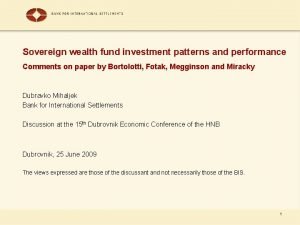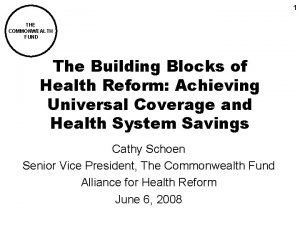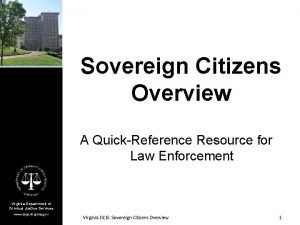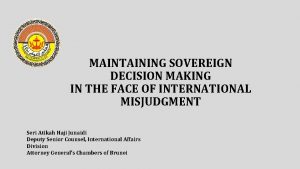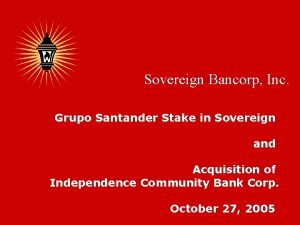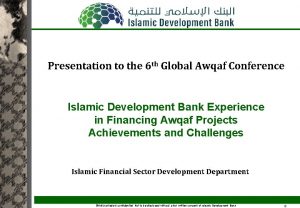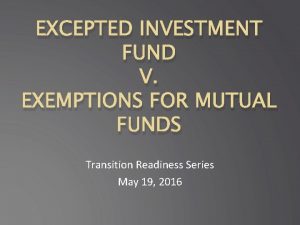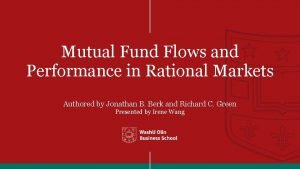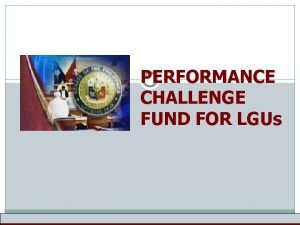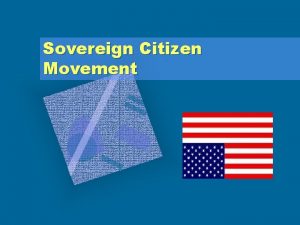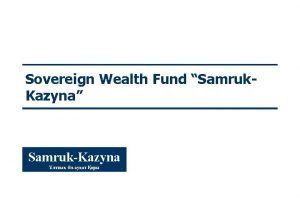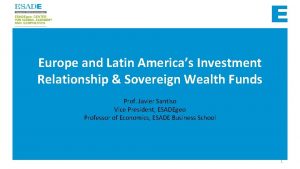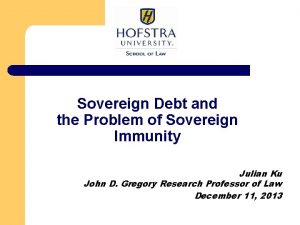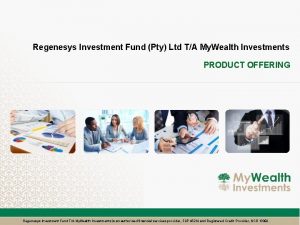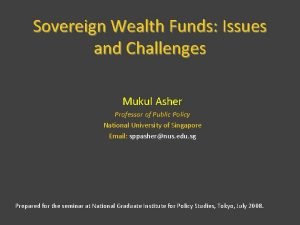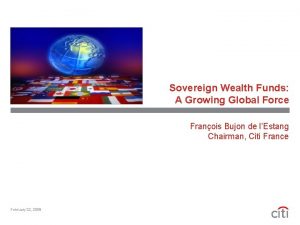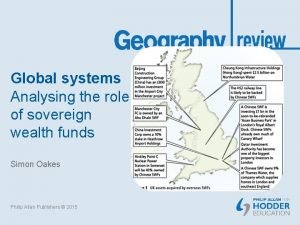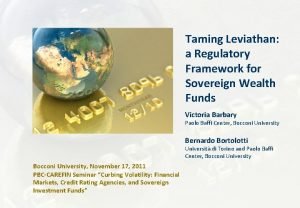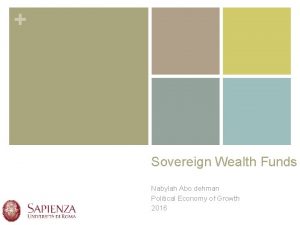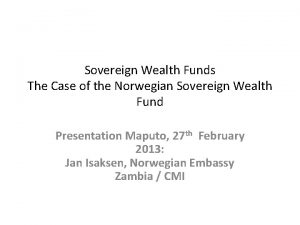Sovereign wealth fund investment patterns and performance Comments




















- Slides: 20

Sovereign wealth fund investment patterns and performance Comments on paper by Bortolotti, Fotak, Megginson and Miracky Dubravko Mihaljek Bank for International Settlements Discussion at the 15 th Dubrovnik Economic Conference of the HNB Dubrovnik, 25 June 2009 The views expressed are those of the discussant and not necessarily those of the BIS. 1

Overview of remarks 1. What we knew about SWFs before this paper 2. Some questions of interest to central banks 3. Questions addressed in the paper 4. Comments on the paper 2

What we knew about SWFs before this paper l SWFs largely found in resource-rich, oil-exporting EMEs l SWFs for the most part funded by real wealth l Only China, Hong Kong SAR and Singapore operate larger sovereign wealth funds in non-resource-based economies. 3

What we knew … 4

What we knew … SWF assets growing rapidly l Private sector estimates: $12 trillion by 2015; larger than forex reserves by 2011 l IMF estimate $6 -10 billion by 2013 l Caveats: estimates based on tenuous assumptions about • future commodity prices • pace of forex reserves accumulation • allocation of the increase in reserves between SWFs and official reserves l 5

What we knew … 6

What we knew … l SWFs play an important role in macroeconomic stabilisation in resource-based economies l Macroeconomic rationale for the operation of SWFs in countries where such funds were carved out of “excess” forex reserves is not obvious l The financial rationale for the operation of such SWFs not entirely clear, either – need to achieve high “hurdle rates” l SWFs probably played an important role in the growth of capital outflows from EMEs 7

SWFs: some questions of interest to central banks 1. Links with fiscal policy 2. Links with monetary and exchange rate policies 3. SWFs and capital flows 8

Links with fiscal policy • Accumulation and withdrawal rules – integration of the fund with the state budget – Norway’s 4% rule • Spending (eg, repayment of public external debt) and/or lending authority (not recommended) • Is there sufficient control of spending and deficits on the regular budget? – Chile’s 1% structural surplus rule Countries with fiscal deficits and/or weak fiscal governance should not establish SWFs 9

Links with monetary and exchange rate policies Case 1: Government has own foreign currency revenue (eg, from exports of state oil or copper company) channel forex revenue to the SWF, invest abroad to avoid exchange rate, inflationary pressures / need for sterilisation Case 2: SWF assets derive from foreign currency acquired through sterilised forex intervention or other borrowed funds – determine the level of “excess” reserves – determine whether the operation of the fund reduces the need for central bank intervention and sterilisation – determine “hurdle” Ro. R > (cost of local debt) + (expected appreciation of local currency) 10

Links with monetary and exchange rate policies (3) • Designing institutional setup of SWF Should the fund be: – Integrated with central bank operations (HKMA); – Operated as a standalone entity (most SWFs); or – Established as a separate unit within the central bank (Norway)? 11

SWFs and capital flows l Role of SWFs in “reverse” capital outflows from EMEs to advanced economies l Role of SWFs from China, Singapore and the Middle East in recapitalising troubled financial institutions from Europe and US in late 2007 and early 2008: $80 billion, 8% of estimated private sector capital outflows from emerging market countries in 2007 l If all SWF assets from EMEs ( $2. 3 tril. ) were invested abroad, they would account for 30% of the foreign assets held by the public and private sectors of EMEs in 2006 12

Questions addressed in Megginson et al paper l What do SWFs invest in? l How do SWFs invest? l Performance of SWF investments Can help central banks and other policy makers understand whether they should worry about SWFs, set up their own SWF 13

Comments on Megginson et al paper l Paper addressed to the academic / empirical finance community l Unique data base l Descriptive and statistical analysis of the data on SWF transactions l Econometric analysis of the determinants of “abnormal” returns 14

Comments l (Moderately) heavy on finance jargon l Important terms (“abnormal” returns, agency costs, various SWF indices) not explained / not explained well until very late in the paper l Imbalance between the descriptive narrative (long) and technical analysis (often cursory) 15

Comments Statistical methodology l Definition of “abnormal” returns: deviation from the local equity index l Is only the average return “normal”? Shouldn’t there be some confidence bands around the average return? 16

Comments Econometric methodology l OLS l Dependent variable is constructed (“abnormal” return) l 13 explanatory variables • 6 dummy variables • 4 constructed variables (Truman indices of SWF governance ) • 1 lagged dependent variable • 2 variables measuring percentage of shares acquired (%, % squared) 17

Comments l How informative are such regressions? l Most parameter estimates insignificant l Have potential problems with multicollinearity (dummy variable trap) in panel data estimations (especially with fixed effects) been properly treated? 18

Comments Can we take Truman indices at face value? l No discussion of their reliability; black boxes l Indices of governance, accountability and transparency, behaviour, are bound to be highly correlated l Look at Aizenman and Glick (SFO Fed, Dec. 2008) 19

Comments l l l How do results in the paper compare with published reports about SWF performance? Norway’s Pension Fund – Global Temasek: average annual return on assets 18% in local currency terms during the lifetime of its operations; 27% during 2006 -07 GIC (at the 25 th anniversary of its founding): average annual yield on its investments from 1981 to 2006 • 9. 5% in US dollar terms • 8. 2% in SGD • 5. 3% above global (G-3) inflation 20
 Sovereign wealth fund investment patterns and performance
Sovereign wealth fund investment patterns and performance The common wealth fund
The common wealth fund Macbeth seyton i am sick at heart
Macbeth seyton i am sick at heart Fixed investment and inventory investment
Fixed investment and inventory investment Imprest fund system and fluctuating fund system
Imprest fund system and fluctuating fund system Sovereign citizen virginia
Sovereign citizen virginia Sovereign decision
Sovereign decision Sovereign bancorp inc
Sovereign bancorp inc Spirit of the sovereign lord is upon me
Spirit of the sovereign lord is upon me Aqha uk
Aqha uk Sovereign posture
Sovereign posture Define citizen developer
Define citizen developer Sovereign state
Sovereign state Awqaf properties investment fund
Awqaf properties investment fund Excepted investment company
Excepted investment company Practical investment fund
Practical investment fund Egfe
Egfe Excepted investment fund
Excepted investment fund Mutual fund flows and performance in rational markets
Mutual fund flows and performance in rational markets Associations and correlations in data mining
Associations and correlations in data mining Performance challenge fund logo
Performance challenge fund logo
